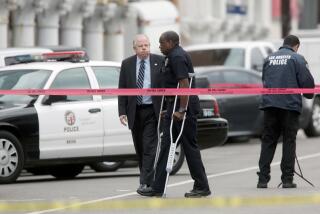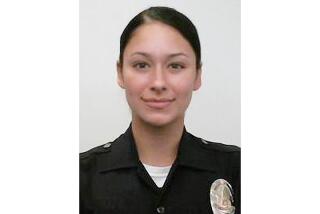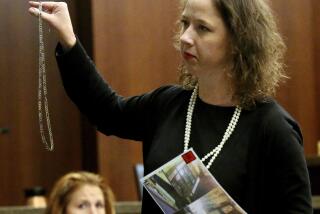Officer Won’t Face Trial in Fatal Shooting
The Los Angeles County district attorney’s office will not prosecute an LAPD officer who fatally shot a mentally ill homeless woman in May 1999, concluding in a report released Tuesday that the officer may have acted in self-defense or by accident.
Officer Edward Larrigan shot Margaret Laverne Mitchell in the chest after she allegedly lunged at him with a 12-inch screwdriver. Her death sparked protests by civil rights activists and police critics and led to a $975,000 civil settlement by the Los Angeles City Council. It also prompted an ongoing FBI investigation to determine whether Larrigan used excessive force or violated the civil rights of the 55-year-old woman.
Dist. Atty. Steve Cooley in January launched a grand jury investigation into the shooting but concluded that the witness testimony was too compromised to justify criminal prosecution.
Cooley was unavailable for comment Tuesday, but Deputy Dist. Atty. Susan Chasworth said prosecutors lacked a clear picture of the shooting and were not confident that they could get a guilty verdict from a jury.
“There is too much confusion and there is too much conflict for us to be able to present a credible, coherent theory of what happened,” said Chasworth, who reviewed evidence and wrote the report. “We really don’t know what occurred in the moments before she was shot.”
The 60-page report said the evidence was compromised because some witnesses changed their statements, while others declined to be interviewed without an attorney present. Chasworth placed some blame on Mitchell’s family attorney, Leo Terrell, whom she accused of tainting witness testimony and interfering with the investigation.
Terrell’s behavior “may have affected the quality of the testimony we ended up with,” Chasworth said.
Terrell said he was insulted by the accusations and outraged by the decision not to prosecute Larrigan. He believed there was enough evidence for manslaughter charges to be filed against the officer.
Terrell said he expected Cooley, who defeated Gil Garcetti for district attorney last year, to lead an investigation that would have brought justice to Mitchell’s family.
“Steve Cooley campaigned on the back of Margaret Mitchell,” Terrell said. “Shame on him.”
The Beverly Hills attorney said the decision sends a dangerous message to officers in the Los Angeles Police Department.
“Officers are allowed to shoot homeless people and get away with it,” he said. “That’s what this says.”
According to police accounts, Mitchell was pushing a shopping cart near 3rd Street and La Brea Avenue about 4 p.m. on May 21, 1999, when she was spotted by two officers on bicycles. The officers, Larrigan and Kathy Clark, believed the cart was stolen and tried to question Mitchell.
Police said she began walking away but stopped and began shouting obscenities at the officers. Police said Mitchell pulled out the screwdriver, threatened to kill the officers and lunged at them. Larrigan feared for his life and fired a single shot that struck her in the chest, police said. Mitchell died shortly thereafter at Cedars-Sinai Medical Center.
Some witnesses told investigators that Mitchell never lunged at the officers with her screwdriver. Terrell said he believes that Mitchell was running away when she was shot.
“The biggest lie in the world is this man saying he feared for his life,” Terrell said.
Chasworth detailed three possible scenarios in the report: Larrigan accidentally shot Mitchell when he lost his balance; he fired in self-defense when Mitchell attempted to stab him with the screwdriver; or he shot her without provocation as she fled from him.
Chasworth said the events might have been clearer if “Operation Rollout”--a district attorney program that investigates police shootings--had been in effect. The program was reinstated about seven months after Mitchell’s death.
In addition to spurring criticism of the Police Department from advocates for the mentally ill, the shooting sparked a heated controversy between Police Chief Bernard C. Parks and the Los Angeles Police Commission.
Parks found that Larrigan used faulty tactics when he shot Mitchell, but did not violate department policy that allows officers to fire their weapons to protect themselves.
But the commission, the civilian panel that oversees the LAPD and all officer-involved shootings, overruled him. The commission concluded that Larrigan violated rules on shootings and that Mitchell, a frail 5-foot-1 woman, did not pose a deadly threat.
Cmdr. Sharon Papa, an LAPD spokeswoman, said the department was confident that the decision not to file charges was the right one. The district attorney’s office “spent a lot of time on this,” she said.
But community activists and Mitchell’s family have demanded to know why officers did not use nonlethal means to subdue the 102-pound woman.
During the district attorney’s investigation, prosecutors analyzed physical evidence, reviewed transcripts and tape recordings of interviews, and reviewed FBI reports. They also interviewed 11 witnesses and discovered that three witnesses “radically changed” their statements. Other witnesses refused to be interviewed without an attorney, which “prevented early, untainted interviews” and “destroyed any appearance of impartiality,” the report said.
During the grand jury proceedings, witnesses gave varying accounts of what happened and what Mitchell was doing with the screwdriver.
For example, witness James Moody said that Mitchell was waving the screwdriver up and down, but that she was not trying to hit, cut or stab Larrigan. However, Derrick Keaton testified that Mitchell made overhead stabbing motions with the screwdriver.
If prosecutors could have conducted interviews earlier and without interference, the report said, “not only would a clearer picture of the shooting emerged, but this office would have resolved the matter much sooner.”
MORE INSIDE
Case reopened: The Police Commission orders reexamination of controversial 1999 incident. B4
More to Read
Sign up for Essential California
The most important California stories and recommendations in your inbox every morning.
You may occasionally receive promotional content from the Los Angeles Times.










